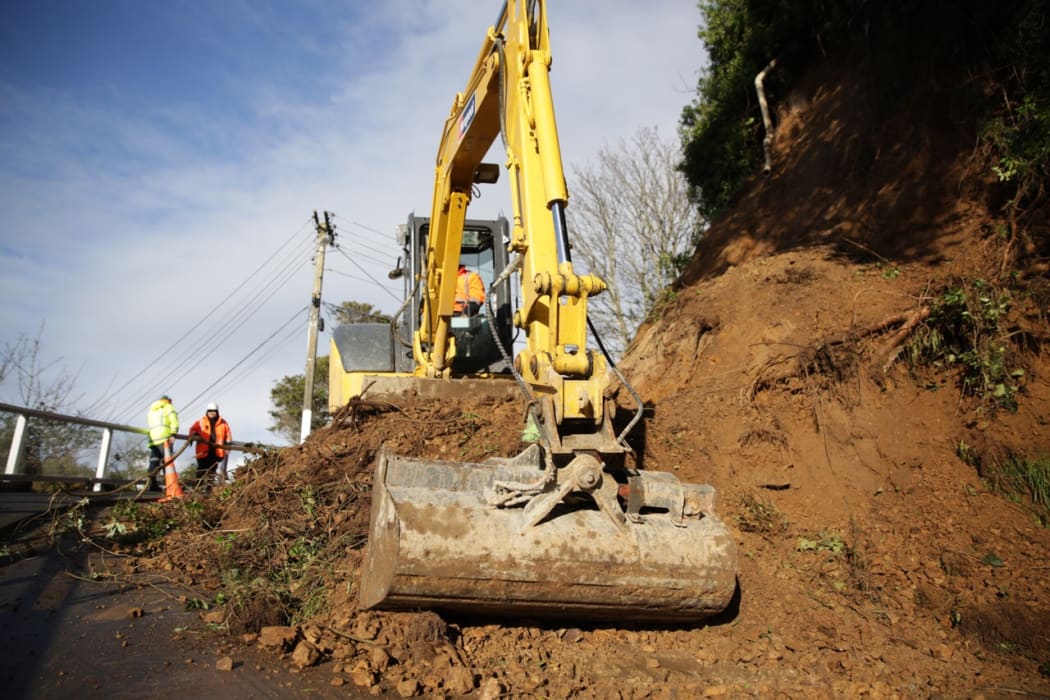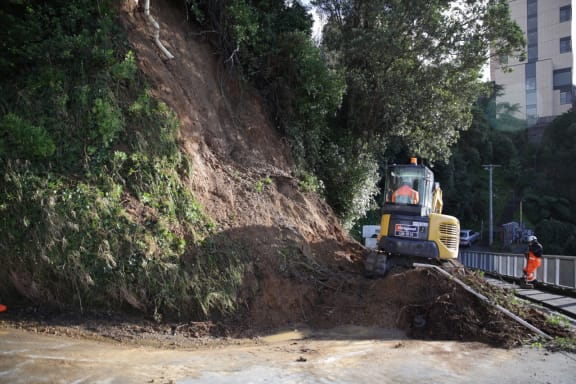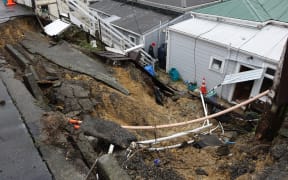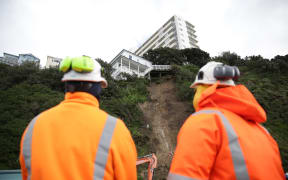New Zealand earns its 'shaky isles' moniker.
But landslides are an under-appreciated natural hazard.
So far this winter, the capital's built environment has been tested with more than 450 slips, including two large ones this week that forced two families to flee their homes.

A landslip in Wellington this week saw homes evacuated. Photo: RNZ / Rebekah Parsons-King
On average, there are three deaths a year from landslides in New Zealand and there are more recorded fatalities - 700 deaths - from slips than earthquakes and tsunami, says GNS Science engineering geologist Chris Massey.
"That number of fatalities is higher than earthquakes and tsunami.
"So landslides are a real problem. It's not just the deaths, the people that they kill, but it's also the damage to property, the damage to infrastructure.''
GeoNet said there were about 400 slips on artificial slopes on the Wellington City Council road network each year.
Mr Massey said most slips were triggered by rainfall and the main factors influencing the risk of a landslide are geology, climate, and land use.
''The thing is, though, not many people live on slopes… Many in Wellington do, but in the rest of the country a lot of people don't live on slopes so the risk isn't evenly distributed across the whole population. It's kind of weighted to the people who live on slopes.''
Wellington's built environment has been tested over the decades with high intensity rainfall events, but it has not been tested by a large earthquake generated by the region's closest faults - the Wellington fault and the Hikurangi subduction zone off the east coast of the North Island.

This week's slip in Wellington. Photo: RNZ / Rebekah Parsons-King
In hilly Wellington, a lot of the land has been modified to accommodate buildings, roads, and infrastructure.
''These modified slopes, because they've only been really constructed since the 1930s, 40s, 50s, and have never actually seen a really strong earthquake… we really don't know how these slopes will perform under a really strong earthquake. Not like the earthquake we've had recently in Wellington but a real strong earthquake, something like a Kaikōura type of earthquake.
''They've been tested for rain.
''They haven't really been tested for strong ground shaking associated with a large earthquake.''
New Zealand is tectonically active and temperate, with high annual rainfall, which means the landscape is dynamic and slip-prone.
The majority of slips are triggered by rain. Geology, climate, and change in land use are the main factors.
Mr Massey said the capital had a history of landslides.
''In the past we've had similar landslides under similar rainfall conditions.
''When it rains… it increases the mass of the slope and decreases the effect of stress of the material. By doing that it reduces the strength of the material because the water kind of percolates in through the pores of the material.''
As rainfall intensifies, a slope saturates and essentially liquefies, reducing the material's strength.
The higher the rainfall intensity, the more landslides happen.
Wellington was built on steep slopes on greywacke. Slip-prone land tended to sit on top of rock defects filled with weaker material or areas where runout was possible, Massey says.
Whether a slope is susceptible to slipping depends on material type, soil or rock, and the angle.
''Those kinds of slopes will not be stable at the same slope angle as other slopes that say didn't have those defects in them, or the orientations were more favourable for stability.
''It's a really complicated issue.
''For different types of soil and rock we have different angles that the slopes are comfortable or stable at and you can calculate a probability of a landslide occurring in different combinations of material type and at different slope angles, different rain or earthquake events.''
National Institute of Water and Atmospheric Research marine geologist Dr Josh Mountjoy says many areas sit on greywacke, a weathered, fractured, and porous sandstone.
''The Tararua range and a lot of the mountains in the South Island are all underlain by greywacke.
''It underlies most of the country and all of the hills around Wellington are greywacke material.
''It's a hugely variable material - the characteristic is it's just been through a huge amount of tectonic deformation - basically being chopped up by a lot of faults and folded by earthquakes and fractured over a long, long period of time.
''Overall it's become quite a weak rock mass that is susceptible to failure.''
GeoNet says there have been more than 2000 claims for damage from landslips in Wellington since 1990.
An ancient landslide at Green Lake in Fiordland - thought to be the largest in the world - dumped 27 cubic kilometres of material over 45 square kilometres between 12,000 and 13,000 years ago.




